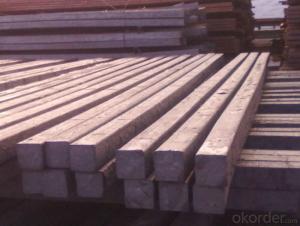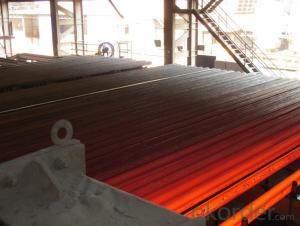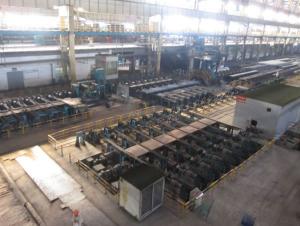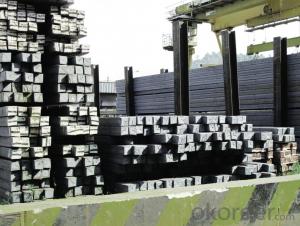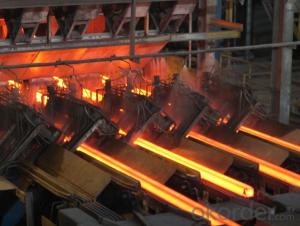Prime square alloy steel billet 80mm Q235
- Loading Port:
- Shanghai
- Payment Terms:
- TT OR LC
- Min Order Qty:
- 100 m.t.
- Supply Capability:
- 10000 m.t./month
OKorder Service Pledge
OKorder Financial Service
You Might Also Like
Structure of Prime square alloy steel billet 80mm Q235

Description of Prime square alloy steel billet 80mm Q235
1. Prepainted steel coil is coated with organic layer, which provides higher anti-corrosion property and a longer lifespan than that of galvanized or galvalume steel sheets.
2. The base metals for prepainted steel coil consist of cold rolled, HDGI Steel, electro-galvanized and hot-dip alu-zinc coated steel. The finish coats of prepainted steel coil can be classified into groups as follows: polyester, silicon modified polyesters, polyvinylidene fluoride, high-durability polyester, etc.
3. The production process has evolved from one-coating-and-one-baking to double-coating-and-double-baking, and even three-coating-and-three-baking.
4. The color of the prepainted steel coil has a very wide selection, like orange, cream-colored, dark sky blue, sea blue, bright red, brick red, ivory white, porcelain blue, etc.
5. The prepainted steel coils can also be classified into groups by their surface textures, namely regular prepainted sheets, embossed sheets and printed sheets.

Main Feature of Prime square alloy steel billet 80mm Q235
Uncoated CR steel sheet
With the features of in line with the international highest standards in demension and shape, excellent surface finish and properties, the products are mainly used in home appliance and automobile industries.
Galvanized steel sheet(include HDG and EG)
With the features of good corrosion resistance, the products are mainly used in automobile, home appliance, electronics, building and machinery manufacture industries, etc.
Precoated steel sheet
With the features of enviromental protection and good processablility, long lasting surface durability, rich in colors, the products are maily used in building, home appliance and furniture industries, etc.
Applications of Prime square alloy steel billet 80mm Q235
A. Corrugated design makes it excellent waterproof performance
B. Materials as prepainted steel sheets, galvanized steel sheets, galvalume (Al-Zn coated sheets) are available to make corrugated sheet.
C.Those material are durable, anti-corrosion in bad weather for 20-30 years based on it's Zinc(Galvanized) coating or AZ (Galvalume) coating.
D. Different shape of the sheet make it suitable for any style of buildings.
E.Easy to install, no need special tools to fix the sheet.
F.Light weight due to high strength to weight ratio of steel. Light weight means easier handling lower shipping costs, easier installation
G. Different color is availbe base on the RAL Standard make your building more beautiful.
H. We will provide the best solutions if you don't have a exact idea of the specification you want for the steel sheet based on your weather conditions, engineering structure, construction budget and so on.

Specifications of Prime square alloy steel billet 80mm Q235
Product | Billet |
Material Grade | SGCC / SGCH / DX51D+AZ, etc |
Thickness | 0.6-3.0mm |
Width | 500-1500mm |
Tolerance | Thickness: +/-0.02mm , Width:+/-2mm |
Zinc-coating | Z30-150g/m2 |
Technique | Raw material: Hot rolled steel coil --> Cold rolled_>hot dipped galvalume |
Surface | Dried, Chromated, Unoiled |
Spangle | Regular spangle , small spangle, zero spangle |
ID | 508MM 610MM |
Coil weight | 1-25MT |
Export package | Cardboard inner sleeves, Waterproof paper, galvanized steel covered and steel strip packed |
FAQ of Prime square alloy steel billet 80mm Q235
We have organized several common questions for our clients,may help you sincerely:
1. How Can I Visit There?
Our company is located in Tianjin City, China, near Beijing. You can fly to Tianjin Airport Directly. All our clients, from home or aboard, are warmly welcome to visit us!
2. How Can I Get Some Sample?
We are honored to offer you sample.
3. Why choose CNBM?
we always fix steel produce in container well to make it safe arrive at destination port
we always provide best and professional forward service for our buyer
we always apply 14days free detention for our buyers container in destination
we provide one set After-sales service for our buyer
we provide China inland steel market price report
we help our buyer become number one in local market .
- Q:Are steel billets used in the aerospace industry?
- Undoubtedly, steel billets find usage in the aerospace field. Steel holds immense importance in the aerospace sector owing to its exceptional strength, durability, and resistance against corrosion. As semi-finished steel products, steel billets assume a solid form and serve as raw materials for crafting diverse components in the construction of aircraft and spacecraft. These billets frequently undergo further processing, such as forging, rolling, or extrusion, to attain the desired shapes and sizes necessary for aerospace applications. These components encompass vital structural parts like frames, wings, landing gears, and engine components, wherein the strength and dependability of steel are paramount to ensuring the safety and performance of the aircraft. Furthermore, steel billets also find employment in the production of tools, fixtures, and machinery employed within the aerospace industry. As a whole, steel billets play a momentous role in the aerospace field, contributing to the manufacturing of robust, reliable, and high-performance aerospace equipment.
- Q:20 what is the difference between manganese silicon steel billet and Q235 billet?
- 20 manganese silicon steel billet for high strength steel,Q235 billet is almost the most common steel, requiring the lowest.
- Q:What are the different types of steel billet welding processes?
- There are several types of steel billet welding processes, including submerged arc welding (SAW), gas metal arc welding (GMAW), shielded metal arc welding (SMAW), and flux-cored arc welding (FCAW). These processes differ in the type of electrode and shielding method used, as well as the specific conditions and equipment required for each process.
- Q:What are the different heat treatment processes for steel billets?
- The different heat treatment processes for steel billets include annealing, normalizing, quenching, tempering, and stress relieving.
- Q:How are steel billets used in the shipbuilding industry?
- Steel billets are used in the shipbuilding industry as a primary raw material for manufacturing various components of a ship's structure, such as hulls, decks, and bulkheads. These billets are melted, cast, and then rolled into the desired shape or size to meet the specific requirements of the ship's design. The high strength and durability of steel make it ideal for withstanding the harsh marine environment and ensuring the structural integrity of the vessel.
- Q:What is the role of steel billets in the manufacturing of structural steel bridges?
- Structural steel bridges heavily rely on steel billets, which are essential semi-finished products utilized as the raw material for manufacturing various steel products, including these bridges. The initial step involves heating the steel billets and passing them through a series of rolling mills to shape them accordingly. This rolling process ensures that the billets are converted into elongated, slender sections suitable for bridge construction. Once the steel billets have been rolled into the desired forms, they undergo further processing and fabrication to create the necessary components for structural steel bridges. These components encompass beams, columns, girders, and other vital elements that contribute to the bridge's strength, stability, and load-bearing capabilities. The utilization of steel billets in the production of structural steel bridges provides numerous advantages. Firstly, steel possesses an exceptional strength-to-weight ratio, rendering it an ideal material for constructing bridges capable of withstanding heavy loads while remaining relatively lightweight. Moreover, steel's versatility allows for the creation of intricate bridge designs that can accommodate diverse architectural and engineering requirements. Furthermore, steel billets exhibit high durability and resistance to environmental factors like corrosion, which is crucial for ensuring the long-term integrity and safety of the bridge structure. This durability ultimately contributes to the bridge's extended lifespan, leading to reduced maintenance and replacement costs over time. In conclusion, steel billets serve as the fundamental building blocks for the manufacturing of structural steel bridges. Through the rolling and fabrication processes, these billets are transformed into various components that collectively provide strength, stability, and durability to the bridge. The utilization of steel billets enables the construction of bridges capable of withstanding heavy loads, maintaining a lightweight nature, and enduring environmental factors, thereby ensuring the bridge's long-term integrity and safety.
- Q:What are the different methods of steel billet casting?
- In the industry, various methods are commonly used for steel billet casting. These methods encompass continuous casting, ingot casting, and direct casting. Continuous casting stands as the most widely employed method for steel billet casting. In this process, molten steel is poured into a water-cooled mold, typically made of copper. As the steel cools and solidifies, a seamless billet is formed, which is subsequently cut into desired lengths. Continuous casting allows for high production rates and precise control over billet dimensions and quality. Ingot casting represents an alternative method for steel billet casting. It involves pouring molten steel into individual molds to create ingots. These ingots are then allowed to solidify before being reheated and hot rolled into billets. Ingot casting is often utilized for small-scale production or for specialty steel alloys that require specific compositions. Direct casting, also known as strand casting, emerges as a newer method for steel billet casting, eliminating the need for solidification and reheating processes. In this method, molten steel is directly poured into billets through a series of water-cooled copper molds. The billets are subsequently cooled and cut to the desired lengths. Direct casting offers advantages such as reduced energy consumption and improved yield by eliminating the intermediate steps of ingot casting. Ultimately, the selection of the steel billet casting method relies on factors like production volume, desired quality, and specific requirements of the steel alloy being produced. Each method possesses its own advantages and limitations, and choosing the appropriate method is vital for ensuring efficient and cost-effective steel billet production.
- Q:What are the different shapes and forms of steel billets?
- Steel billets come in a variety of shapes and forms depending on their intended use and manufacturing process. The most common shapes of steel billets include square, rectangular, round, and hexagonal. These shapes are typically achieved through a process called casting, where molten steel is poured into a mold and left to solidify. Square billets are the most commonly used shape and are often produced for rolling into long products like bars, rods, and wire. Rectangular billets, which have longer sides compared to their width, are also used for rolling into long products but are typically used for applications that require a larger cross-sectional area. Round billets, as the name suggests, are cylindrical in shape and are primarily used for the production of seamless tubes, pipes, and other tubular products. The round shape is preferred for these applications as it allows for a more uniform distribution of stresses during the manufacturing process. Hexagonal billets have six sides and are often used for forging and machining applications. The unique shape of hexagonal billets provides greater strength and stability, making them suitable for producing high-quality components, such as bolts, nuts, and other fasteners. In addition to these common shapes, steel billets can also come in custom shapes and sizes depending on specific requirements. These custom shapes are often achieved by using specialized molds or by further processing the billets through techniques like extrusion or hot rolling. Overall, the different shapes and forms of steel billets allow for the production of a wide range of steel products, each suited to its specific application and manufacturing process.
- Q:What are the different grades of steel billets?
- There are several different grades of steel billets, each with its own specific properties and applications. Some of the commonly used grades include: 1. Mild Steel Billets: These are low carbon steel billets that are often used in general construction and engineering applications. They have a relatively low tensile strength and are easily weldable and formable. 2. Carbon Steel Billets: These contain a higher carbon content than mild steel billets, giving them increased strength and hardness. They are commonly used in the manufacturing of automotive parts, machinery, and tools. 3. Alloy Steel Billets: These are steel billets that have been alloyed with other elements such as chromium, nickel, or molybdenum to improve specific properties. Alloy steel billets offer enhanced strength, toughness, and corrosion resistance, making them suitable for applications in the aerospace, defense, and oil and gas industries. 4. Stainless Steel Billets: These billets contain high levels of chromium and nickel, which provide excellent corrosion resistance and durability. Stainless steel billets are commonly used in the production of kitchen appliances, cutlery, and medical equipment. 5. High-Speed Steel Billets: These billets are alloyed with tungsten, molybdenum, or vanadium to create a steel with exceptional hardness and heat resistance. High-speed steel billets are primarily used in the production of cutting tools such as drill bits and saw blades. It is important to note that the specific grades of steel billets can vary depending on the manufacturing standards and region. These grades are classified based on their chemical composition, mechanical properties, and intended applications, ensuring that the right steel billet is selected for the desired end use.
- Q:What are the main advantages of using steel billets in manufacturing?
- The main advantages of using steel billets in manufacturing include their high strength and durability, versatility in shaping and molding, excellent heat and corrosion resistance, and cost-effectiveness. Steel billets provide a reliable and consistent material for various applications, ensuring structural integrity and longevity in the manufactured products. Additionally, their malleability allows for easy customization and adaptation to different manufacturing processes, making steel billets a preferred choice for many industries.
1. Manufacturer Overview |
|
|---|---|
| Location | |
| Year Established | |
| Annual Output Value | |
| Main Markets | |
| Company Certifications | |
2. Manufacturer Certificates |
|
|---|---|
| a) Certification Name | |
| Range | |
| Reference | |
| Validity Period | |
3. Manufacturer Capability |
|
|---|---|
| a)Trade Capacity | |
| Nearest Port | |
| Export Percentage | |
| No.of Employees in Trade Department | |
| Language Spoken: | |
| b)Factory Information | |
| Factory Size: | |
| No. of Production Lines | |
| Contract Manufacturing | |
| Product Price Range | |
Send your message to us
Prime square alloy steel billet 80mm Q235
- Loading Port:
- Shanghai
- Payment Terms:
- TT OR LC
- Min Order Qty:
- 100 m.t.
- Supply Capability:
- 10000 m.t./month
OKorder Service Pledge
OKorder Financial Service
Similar products
New products
Hot products
Related keywords
